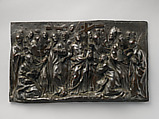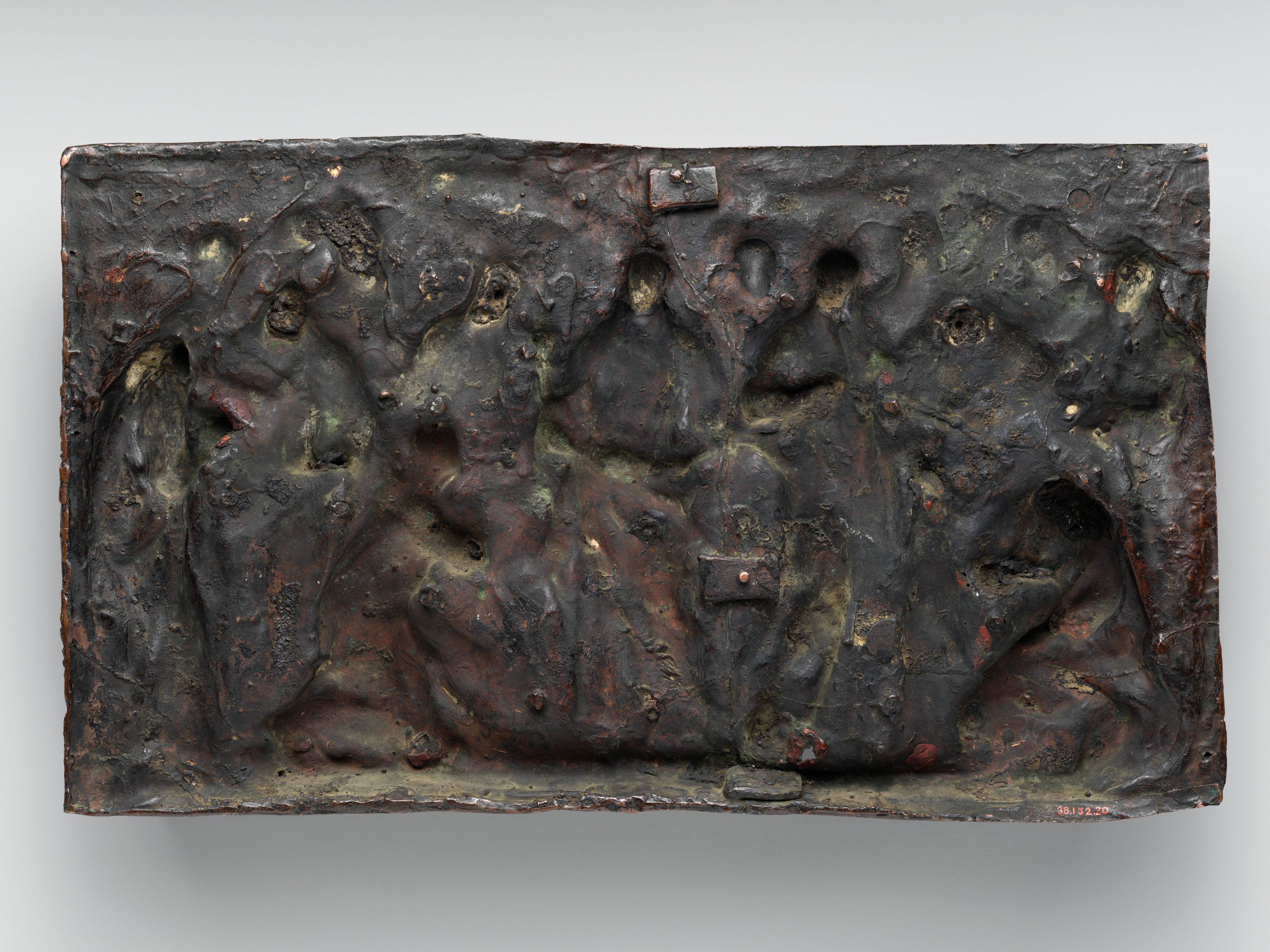Saint Ignatius Loyola with saints and martyrs of the Jesuit order
Alessandro Algardi Italian
Probably cast by Giovanni Andrea Lorenzani
The design of this bronze, an imagined group portrait, was created roughly a century after the founding of the Society of Jesus in 1534 and its official recognition by the papacy in 1540. The relief references the Jesuits’ origins, their global presence, and the order’s promising if as yet undefined future. The scene presents Jesuit figures of various renown whose identities were first proposed by Carlo Bricarelli and either substantiated or clarified by subsequent writers.[1] They include, from left, Peter Canisius (1521–1597), and kneeling before him, Aloysius Gonzaga (1568–1591); Cardinal Robert Bellarmine (1542–1621); Francis Xavier (1506–1552); at center, Ignatius Loyola (1491–1556), with right hand outstretched; Francis Borgia (1510–1572), holding a chalice, with left hand embracing the genuflecting Stanislas Kostka (1550–1568); Andrea Oviedo (1518–1577), with bishop’s miter and crozier; and Ignazio de Azevedo (1526–1570), holding an icon of the Virgin and Child. The background contains three figures holding crosses—the Japanese martyrs John de Goto, Paul Miki, and James Kisai, all crucified—and groupings of other, less clearly individuated figures.
At a time when the Catholic Church heavily stressed the veneration of its saints, the Jesuits found themselves in what Gauvin Bailey has described as a “difficult bind”: the order’s first official saints—Ignatius Loyola and Francis Xavier—were not canonized until 1622.[2] One must note, then, just how extraordinary, if not altogether impudent or presumptuous, the relief’s scene is. At the date of its original design, a mere seven years after the 1622 canonizations, the relief presents several figures (Canisius, Bellarmine, Azevedo) who would not be beatified until the nineteenth or twentieth century, while several others (Kostka, Gonzaga, and Borgia) had only recently received that distinction in the early seventeenth century.
The Met’s relief relates to that on the urn containing Ignatius Loyola’s remains in the extravagant altar dedicated to him on the left transept of the church of the Gesù in Rome (fig. 147a). As part of the larger ensemble, the relatively small plaque makes a potent statement on the Jesuit order’s global mission and unites the martyrs with their venerated founder Loyola for posterity: an aspirational sacred conversation, casting some the Jesuit brethren as future blesseds and saints. By featuring Azevedo, who died en route to Brazil clutching a copy of the Salus Populi Romani icon from the church of Santa Maria Maggiore; Oviedo, Spanish missionary and patriarch to Ethiopia; and the three martyrs killed during a mass crucifixion in Japan in 1597, the relief underlines the order’s impact on the four corners of the world and furthermore connects this activity back to the highly localized site of Loyola’s urn within his Roman chapel in the Jesuit mother church.
Though Alessandro Algardi’s name is not mentioned in the documents related to the urn’s 1629 commission, his authorship has been confirmed based on a preparatory drawing in the Hermitage.[3] A terracotta attributed to Algardi in the Museo di Palazzo Venezia, Rome (fig. 147b) was the likely model for the urn, our relief, and another plaque, with the background cut out, in the Muzeum Narodowe, Kraków.[4] In the rapidly sketched Hermitage drawing (fig. 147c), Algardi first conceived the group as arrayed along a semicircular arc, with figures emanating outward from the central axis along which Ignatius stands. The sculptor’s conception changed in his ultimate design for the urn, employing instead a more regularized, symmetrical group of figures condensed within an oval or rectangular format. There are small differences not only between the terracotta model and the subsequent bronze reliefs but between the reliefs themselves that suggest work done in the wax molds. For example, the urn relief shows a crown at Francis Borgia’s feet, a detail missing in our bronze. Francis Xavier holds a chalice in our plaque and a monstrance in both the urn relief and the terracotta model.
The Met’s relief is cast in two roughly equal parts, and a line separating the figures of Ignatius Loyola and Francis Xavier is visible on the back (fig. 147d). The two sections are joined by laterally projecting tabs integrally cast on the reverse of the proper left section and connected to the right side with screws.[5] The reason for this technique remains unclear,[6] as does the relief’s precise dating, authorship, and function. The looser quality of the afterwork dates it to post Algardi’s lifetime.[7] Harsher draperies than in the Gesù urn, as well, indicate a later hand. Jennifer Montagu has proposed Giovanni Andrea Lorenzani based on the presence of such a relief in the brassworker’s posthumous inventory of 1712.8 Little is known of the relief’s history before entering The Met, but it was likely produced during the second half of the seventeenth century to decorate an altar frontal in a church or private chapel dedicated to the increasingly popular Jesuit order.
-JF
Footnotes
(For key to shortened references see bibliography in Allen, Italian Renaissance and Baroque Bronzes in The Metropolitan Museum of Art. NY: The Metropolitan Museum of Art, 2022.)
1. Bricarelli 1922, p. 113.
2. Bailey 2019, p. 241.
3. Neumann 1977.
4. For the terracotta model, see Giometti 2011, p. 39, with earlier bibliography. For the Kraków relief, see Montagu 1985, vol. 2, pp. 388–89, no. 92.B.1.C.1.
5. R. Stone/TR, January 28, 2011.
6. Richard Stone (ibid.) suggests that it facilitated molding.
7. Montagu 1985, vol. 2, p. 389, no. 92.B.1.C.2.
8. First suggested in ibid., p. 289, and more recently in Montagu 2008, p. 284.
Due to rights restrictions, this image cannot be enlarged, viewed at full screen, or downloaded.
This artwork is meant to be viewed from right to left. Scroll left to view more.



